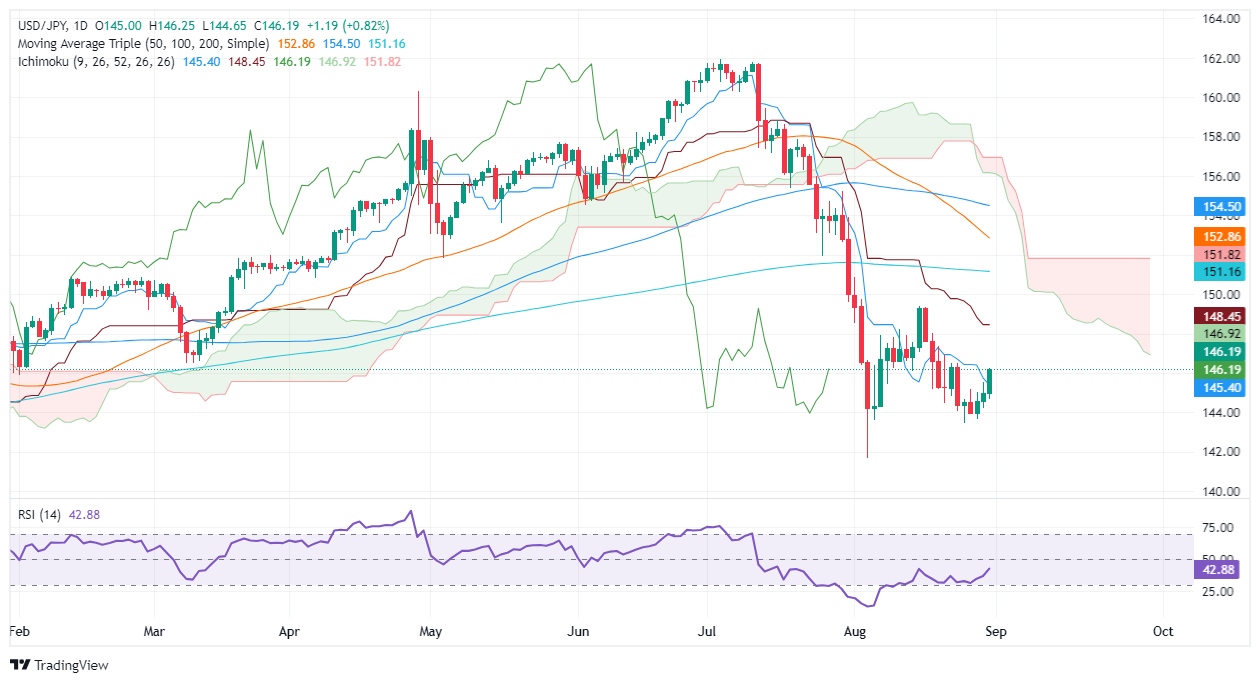- USD/JPY maintains a bearish bias, needing to break key resistances for a bullish turnaround.
- Short-term buying momentum faces hurdles at 146.93 (Senkou Span A) and 148.46 (Kijun-Sen), with an eye on the peak of 149.39.
- Mixed RSI signals suggest short-term buyer dominance but an unclear broader trend.
- A drop below 145.39 (Tenkan-Sen) could trigger further losses, with supports at 143.44 (Aug. 26 low) and 141.69 (Aug. 5 low).
USD/JPY rebounded above the 146.00 figure for the first time this week as US Treasury bond yields rose sharply following the release of the Fed’s flagship inflation report. The US 10-year Treasury note yield rose four and a half basis points to 3.909%, supporting the pair towards 146.17 after bouncing from daily lows of 145.56.
USD/JPY Price Forecast: Technical Outlook
USD/JPY has a bearish bias despite breaking above the Tenkan-Sen at 145.39. The Relative Strength Index (RSI) shows that momentum is mixed, with the indicator in bearish territory but pointing higher.
Short-term buyers are in charge, but they must push the USD/JPY spot price above the Senkou Span A at 146.93 and overcome the Kijun-Sen at 148.46 before they can break above the latest cycle high at 149.39, the daily high from August 15.
Conversely, a move in USD/JPY below the Tenkan-Sen will expose the latest cycle low, seen at 143.44, the low of August 26. The pair could extend its losses beyond that level, and sellers could target August 5 via 141.69.
USD/JPY Price Action – Daily Chart
Japanese Yen FAQs
The Japanese Yen (JPY) is one of the most traded currencies in the world. Its value is determined broadly by the performance of the Japanese economy, but more specifically by the policy of the Bank of Japan, the spread between Japanese and US bond yields, and risk sentiment among traders, among other factors.
One of the Bank of Japan’s mandates is currency control, so its moves are key to the Yen. The BoJ has intervened directly in currency markets on occasion, usually to lower the value of the Yen, although it often refrains from doing so due to political concerns of its major trading partners. The BoJ’s current ultra-loose monetary policy, based on massive stimulus to the economy, has caused the Yen to depreciate against its major currency peers. This process has been exacerbated more recently by a growing policy divergence between the BoJ and other major central banks, which have opted to sharply raise interest rates to combat decades-old levels of inflation.
The Bank of Japan’s stance of maintaining an ultra-loose monetary policy has led to an increase in policy divergence with other central banks, in particular with the US Federal Reserve. This favours the widening of the spread between US and Japanese 10-year bonds, which favours the Dollar against the Yen.
The Japanese Yen is often considered a safe haven investment. This means that in times of market stress, investors are more likely to put their money into the Japanese currency due to its perceived reliability and stability. In turbulent times, the Yen is likely to appreciate against other currencies that are considered riskier to invest in.
Source: Fx Street
I am Joshua Winder, a senior-level journalist and editor at World Stock Market. I specialize in covering news related to the stock market and economic trends. With more than 8 years of experience in this field, I have become an expert in financial reporting.








